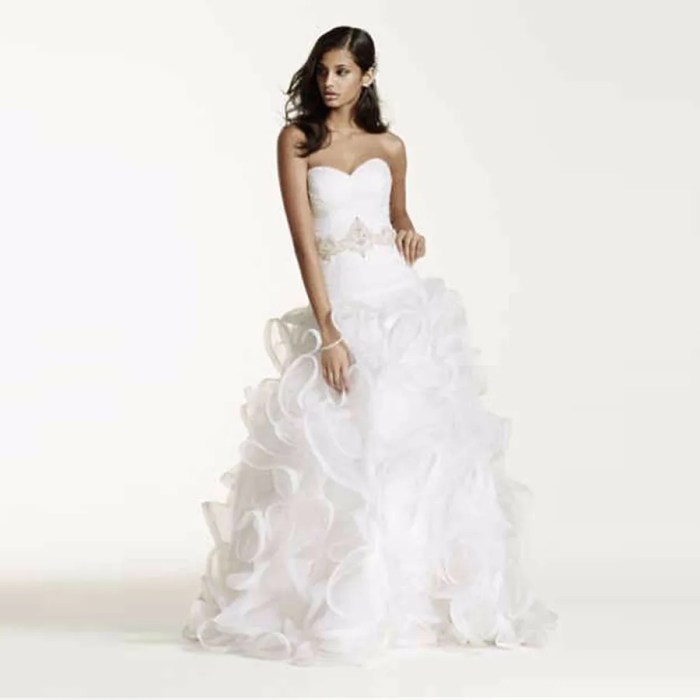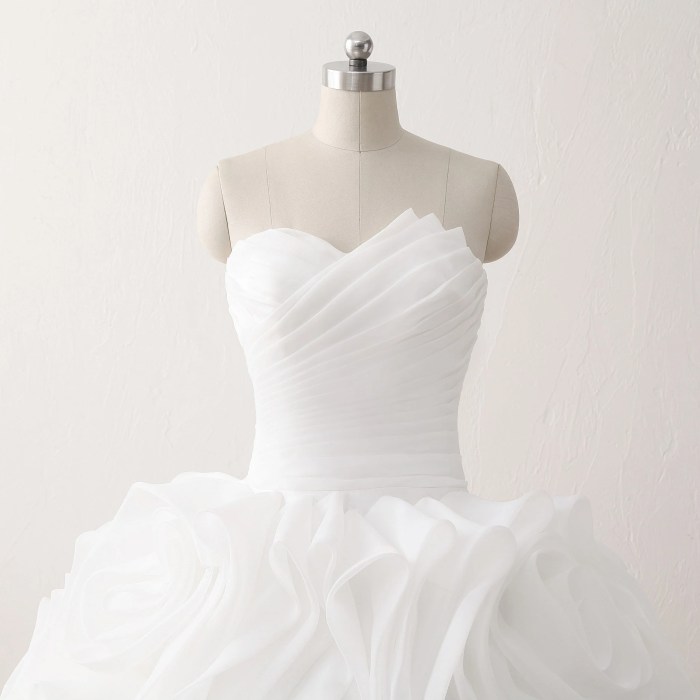Ruffle Skirt Wedding Dresses A Style Guide
Design Aspects of a Ruffle Skirt Wedding Dress
The beauty of a ruffle skirt wedding dress lies in the intricate details and the varied ways ruffles can be incorporated to create a unique and stunning look. The design possibilities are extensive, offering brides a chance to personalize their wedding attire.
Types and Placement of Ruffles
Several ruffle types can enhance a wedding dress skirt. These include cascading ruffles, creating a waterfall effect; tiered ruffles, arranged in horizontal layers; and gathered ruffles, characterized by their soft, voluminous texture. The size and placement of these ruffles significantly impact the overall aesthetic. Larger ruffles add dramatic volume, while smaller ruffles offer a more delicate and refined appearance.
Strategically placing ruffles—for example, concentrating them at the hem or strategically distributing them across the skirt—can create different visual focal points and emphasize the bride’s figure.
Ruffle Construction Techniques
Creating different ruffle styles requires specific construction techniques. Cascading ruffles often involve bias-cut fabric to allow for graceful draping. Tiered ruffles require precise cutting and layering to ensure evenness and create a structured look. Gathered ruffles demand careful gathering to achieve the desired fullness and prevent unevenness. The choice of technique directly influences the final appearance and drape of the skirt.
Fabric Choices for Ruffle Skirts
Fabric selection is crucial for a successful ruffle skirt wedding dress. Lightweight fabrics like silk chiffon, tulle, and organza work well for delicate, flowing ruffles, creating a romantic and ethereal look. Heavier fabrics such as satin or brocade can be used for more structured, dramatic ruffles, offering a luxurious and opulent feel. The fabric’s drape and texture directly influence the overall appearance and movement of the ruffles.
Visual Impact of Different Ruffle Skirt Styles
| Style | Fabric Suggestion | Visual Impact | Suitability for Body Type |
|---|---|---|---|
| A-line | Tulle, Organza | Romantic, Flowing | Most body types |
| Mermaid | Silk Satin, Lace | Dramatic, Figure-Hugging | Hourglass, Pear |
| Ballgown | Tulle, Netting | Voluminous, Princess-like | Most body types |
| Fit-and-Flare | Silk Chiffon, Crepe | Elegant, Defined Waist | Most body types |
Styling and Accessories for a Ruffle Skirt Wedding Dress
Styling a ruffle skirt wedding dress involves careful consideration of neckline, sleeves, and accessories to create a cohesive and flattering look. The overall aesthetic can be dramatically altered through these choices.
Neckline and Sleeve Styles

Source: dhresource.com
A sweetheart neckline complements the romantic nature of a ruffle skirt, while a halter neckline offers a more modern and sophisticated feel. Sleeveless styles showcase the dress’s details, whereas long sleeves or delicate cap sleeves add a touch of elegance or modesty. The choice depends on personal preference and the overall desired style.
Accessories and Hairstyles, Ruffle skirt wedding dress
Accessories play a vital role in enhancing the overall look. A cathedral-length veil adds drama, while a shorter veil provides a more contemporary feel. Delicate jewelry complements the dress without overpowering it. Heels elongate the legs and add elegance, while comfortable flats offer practicality. A variety of hairstyles, from loose waves to an elegant updo, can beautifully complement the dress.
Wedding Looks Featuring a Ruffle Skirt Wedding Dress
- Look 1: Romantic Garden Wedding. A-line ruffle skirt dress in tulle, sweetheart neckline, delicate floral crown, flowing veil, and embellished sandals.
- Look 2: Classic Cathedral Wedding. Mermaid ruffle skirt dress in silk satin, bateau neckline, long sleeves, cathedral-length veil, pearl earrings, and elegant heels.
- Look 3: Modern Beach Wedding. Fit-and-flare ruffle skirt dress in crepe, off-the-shoulder neckline, simple jewelry, barefoot, and loose, beachy waves.
Fabric and Silhouette Considerations

Source: etsystatic.com
The choice of fabric and silhouette significantly impacts the overall look and feel of a ruffle skirt wedding dress. Understanding the properties of different fabrics and how they interact with various silhouettes is crucial for creating the desired aesthetic.
Fabric Comparison and Silhouette Effects
Silk offers a luxurious drape and subtle sheen, while tulle creates volume and texture. Lace adds intricate detail and romantic appeal. The choice of fabric affects the ruffles’ movement and drape; lightweight fabrics create a softer, more fluid look, while heavier fabrics provide more structure and definition. A-line silhouettes flatter most body types, while mermaid silhouettes accentuate curves.
Ballgown silhouettes offer maximum volume and drama.
Fabric Weight and Volume
The volume and weight of the fabric directly influence the design and construction of the ruffle skirt. Lighter fabrics require more ruffles to achieve the desired volume, while heavier fabrics create a more structured and less voluminous look. The weight also impacts the overall comfort and movement of the dress.
Advantages and Disadvantages of Fabric Choices
- Silk: Advantages – luxurious drape, subtle sheen; Disadvantages – can be delicate and expensive.
- Tulle: Advantages – creates volume, affordable; Disadvantages – can be stiff and less comfortable.
- Lace: Advantages – adds intricate detail, romantic; Disadvantages – can be heavy and less forgiving.
Visual Representation and Inspiration
The visual impact of a ruffle skirt wedding dress is greatly enhanced by attention to detail, photography, and setting. The interplay of texture, movement, and color creates a memorable and stunning effect.
Detailed Dress Descriptions
Imagine a cascading ruffle skirt wedding dress in ivory silk chiffon, adorned with delicate lace appliqués. The A-line silhouette flows gracefully, complemented by a sweetheart neckline and delicate cap sleeves. The movement of the ruffles is ethereal, creating a sense of romance and elegance. Another design could feature a tiered ruffle skirt in blush-colored tulle, creating a voluminous and princess-like silhouette.
A fitted bodice with a V-neckline adds a touch of modern sophistication. Finally, consider a mermaid ruffle skirt dress in white satin, featuring structured ruffles that create a dramatic and figure-hugging silhouette. A high neckline and long sleeves add a touch of classic elegance.
Lighting, Color, and Setting
Soft, natural light enhances the texture and movement of the ruffles, highlighting the intricate details of the dress. Subtle color variations, such as an ivory dress with blush undertones, can add depth and dimension. A garden wedding setting with lush greenery and vibrant flowers perfectly complements the romantic nature of a ruffle skirt wedding dress, creating a breathtaking and unforgettable visual spectacle.
Quick FAQs: Ruffle Skirt Wedding Dress
Can I wear a ruffle skirt wedding dress if I’m petite?
Yes, choose a dress with shorter ruffles or a less voluminous skirt to avoid overwhelming your frame. An A-line silhouette is generally flattering on petite figures.
How do I care for a ruffle skirt wedding dress after the wedding?
Professional dry cleaning is recommended. Follow the care instructions provided by the designer or manufacturer to maintain the dress’s condition.
Are ruffle skirt wedding dresses suitable for all seasons?
The suitability depends on the fabric. Lightweight fabrics like silk chiffon are better for warmer months, while heavier fabrics like velvet or brocade are more suitable for colder seasons.
What type of undergarments should I wear with a ruffle skirt wedding dress?
Seamless shapewear or a smooth, comfortable bra are recommended to avoid visible lines under the dress. Consider the fabric and style of the dress when choosing undergarments.



















